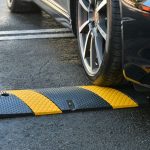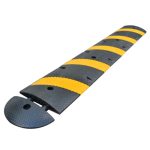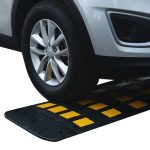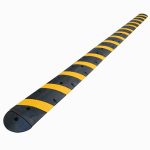Importance of speed bumps in commercial properties
Speed bumps are an essential safety feature for commercial properties, especially those with high traffic volume. They help to slow down vehicles and prevent accidents, making the property safer for pedestrians and drivers alike. Speed bumps also help to control the speed of vehicles in parking lots, driveways, and other areas where vehicles are likely to be moving at high speeds. By installing the right rubber speed bumps, property owners can ensure that their property is safe and secure for everyone who uses it.
Factors to consider when choosing rubber speed bumps
When choosing rubber speed bumps for your commercial property, there are several factors to consider. Firstly, you need to determine the speed limit of the area where the speed bumps will be installed. This will help you choose the appropriate height and length of the speed bumps. Secondly, you need to consider the type of vehicles that will be using the area. Heavy-duty vehicles will require more durable and sturdy speed bumps. Additionally, you need to consider the weather conditions of the area. If the area experiences extreme temperatures or heavy rainfall, you need to choose speed bumps that can withstand these conditions. Lastly, you need to consider the visibility of the speed bumps. Choosing brightly colored speed bumps or adding reflective tape can increase their visibility and reduce the risk of accidents.
Types of Rubber Speed Bumps
Traditional Speed Bumps
Traditional speed bumps are the most common type of speed bump and are typically made of asphalt or concrete. They are effective at slowing down traffic, but can be harsh on vehicles and cause damage if drivers go over them too quickly. Additionally, traditional speed bumps can be difficult to install and remove, making them less flexible than other options. However, they are a cost-effective solution and can be painted to increase visibility.
Low Profile Speed Bumps
Low profile speed bumps are a great option for commercial properties where speed reduction is necessary but the visual impact of traditional speed bumps is not desired. These speed bumps are designed to be less noticeable and blend in with the surrounding pavement. They are typically made of durable rubber materials and can withstand heavy traffic and extreme weather conditions. Low profile speed bumps are also ideal for areas where emergency vehicles need to pass through without slowing down. They provide a smooth ride for vehicles while still effectively slowing down speeds.
Cable Protectors
Cable protectors are another type of rubber speed bump that can be useful for commercial properties. These speed bumps are designed to protect cables and wires that may be running across the ground, preventing them from being damaged by vehicles or pedestrians. Cable protectors are typically wider and flatter than traditional speed bumps, allowing for cables to be easily placed inside. They also often have a non-slip surface to prevent slips and falls. If your property has a lot of cables or wires running across the ground, cable protectors may be a good option to consider.
Portable Speed Bumps
Portable speed bumps are a great option for commercial properties that require temporary speed control. These speed bumps can be easily moved and stored when not in use, making them ideal for events or construction sites. Portable speed bumps are typically made of durable rubber and come in various lengths and widths to accommodate different types of vehicles. They can also be customized with reflective strips for increased visibility at night. However, it is important to note that portable speed bumps may not be as effective as permanent speed bumps in slowing down vehicles, especially if they are not anchored securely to the ground.
Factors to Consider When Choosing Rubber Speed Bumps
Traffic Volume
When considering the traffic volume of your commercial property, it is important to choose rubber speed bumps that can withstand heavy usage. For high traffic areas, it is recommended to select speed bumps that are made of durable materials such as recycled rubber or plastic. These materials are able to withstand the weight of heavy vehicles and constant use without deteriorating quickly. Additionally, it is important to choose speed bumps that are visible and clearly marked to ensure the safety of drivers and pedestrians. Reflective markings or bright colors can help increase visibility and reduce the risk of accidents.
Speed Limit
When choosing the right rubber speed bumps for your commercial property, it’s important to consider the speed limit of the area. If the speed limit is low, such as in a parking lot or near a pedestrian area, a lower profile speed bump may be sufficient. However, if the speed limit is higher, such as on a busy road or highway, a higher profile speed bump may be necessary to effectively slow down vehicles and ensure the safety of pedestrians and other drivers. It’s important to consult with a professional to determine the appropriate height and placement of speed bumps based on the speed limit of your commercial property.
Vehicle Type
When choosing the right rubber speed bumps for your commercial property, it’s important to consider the types of vehicles that will be using them. If your property sees a lot of heavy-duty trucks or buses, you’ll want to opt for speed bumps that are designed to withstand their weight and size. On the other hand, if your property primarily sees passenger cars and smaller vehicles, you may be able to choose a more standard speed bump option. It’s important to consider the weight and size of the vehicles that will be using the speed bumps to ensure they are effective and safe for all drivers.
Installation Location
When it comes to installing rubber speed bumps on your commercial property, the location is crucial. You want to place them in areas where drivers are most likely to speed or where pedestrian traffic is high. Some common locations include parking lots, driveways, and loading docks. It’s important to also consider the slope of the road or driveway where the speed bump will be installed. If the slope is too steep, it can cause damage to vehicles or make it difficult for drivers to navigate. Proper installation location can ensure the effectiveness of the speed bumps in slowing down traffic and improving safety on your property.
Durability
Durability is a crucial factor to consider when choosing rubber speed bumps for your commercial property. You want to invest in speed bumps that can withstand heavy traffic and extreme weather conditions. Look for speed bumps made from high-quality rubber materials that are resistant to cracking, fading, and deformation. Additionally, ensure that the speed bumps are designed to handle the weight of all types of vehicles, including heavy-duty trucks and buses. By choosing durable rubber speed bumps, you can ensure that your investment will last for years to come and provide a safe and effective traffic calming solution for your property.
Cost
Cost is an important factor to consider when choosing the right rubber speed bumps for your commercial property. While there are various options available in the market, it is essential to choose a speed bump that fits your budget and offers the desired level of safety. The cost of rubber speed bumps can vary depending on the size, material, and design. However, investing in high-quality speed bumps can save you money in the long run by reducing the risk of accidents and damage to vehicles. It is recommended to compare prices and features of different speed bumps before making a final decision.
Installation and Maintenance
Proper Installation Techniques
Proper installation techniques are crucial for ensuring the effectiveness and longevity of your rubber speed bumps. It is important to follow the manufacturer’s instructions carefully and use the appropriate tools and equipment. The surface where the speed bumps will be installed should be clean, dry, and free of debris. The speed bumps should be placed at the recommended distance apart and secured with the appropriate hardware. It is also important to ensure that the speed bumps are level and flush with the surface to prevent tripping hazards. Regular maintenance and inspection of the speed bumps can help identify any issues and ensure they continue to function properly.
Maintenance Tips
Maintenance Tips: To ensure the longevity and effectiveness of your rubber speed bumps, regular maintenance is necessary. It is important to inspect the speed bumps periodically for any signs of damage or wear and tear. If any damage is found, it should be repaired immediately to prevent further deterioration. Additionally, the speed bumps should be cleaned regularly to remove any debris or dirt buildup that may affect their performance. A simple cleaning with soap and water can help keep the speed bumps in good condition. Finally, it is important to ensure that the speed bumps are properly installed and secured to prevent any accidents or damage to vehicles. By following these maintenance tips, you can ensure that your rubber speed bumps continue to serve their purpose effectively and safely.
Common Installation and Maintenance Mistakes to Avoid
When it comes to installing and maintaining rubber speed bumps, there are a few common mistakes that property owners should avoid. One of the most common mistakes is installing speed bumps in areas where they are not needed, which can cause unnecessary wear and tear on vehicles and lead to complaints from drivers. Another mistake is failing to properly maintain the speed bumps, which can cause them to become damaged or ineffective over time. To avoid these issues, it’s important to carefully assess your property’s needs and ensure that your speed bumps are installed and maintained correctly.
Conclusion
Summary of the Importance of Choosing the Right Rubber Speed Bumps
In summary, choosing the right rubber speed bumps for your commercial property is crucial for ensuring the safety of both pedestrians and vehicles. The right speed bumps can help to regulate traffic flow, prevent accidents, and reduce liability risks. Additionally, selecting high-quality rubber speed bumps can provide long-lasting durability and cost-effectiveness, making them a smart investment for any commercial property owner. By taking the time to carefully consider your options and choose the right rubber speed bumps for your property, you can help to create a safer and more efficient environment for everyone who uses it.
Final Thoughts
In conclusion, selecting the appropriate rubber speed bumps for your commercial property is crucial for ensuring the safety of drivers, pedestrians, and property. By considering the factors discussed in this article, such as traffic volume, speed limit, and weather conditions, you can make an informed decision and choose the right speed bumps that meet your specific needs. Remember to also prioritize durability, visibility, and ease of installation when making your selection. With the right rubber speed bumps in place, you can create a safer and more efficient environment for everyone who uses your property.
Next Steps: Now that you have a better understanding of the different types of rubber speed bumps available, it’s time to choose the right one for your commercial property. At Unimat Traffic, we offer a wide range of high-quality rubber speed bumps that are designed to meet your specific needs. Our team of experts can help you select the perfect speed bump for your property and provide you with all the information you need to make an informed decision. Visit our website today to learn more about our products and services and to get started on your order.








